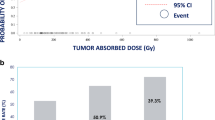Abstract
Purpose
Repeated radioembolization (RE) treatments carry theoretically higher risk of radiation-induced hepatic injury because of the liver’s cumulative memory of previous exposure. We performed a retrospective safety analysis on patients who underwent repeated RE.
Methods
From 2004 to 2011, a total of 247 patients were treated by RE. Eight patients (5 men, 3 women, age range 51–71 years) underwent repeated treatment of a targeted territory, all with resin microspheres (SIR-Spheres; Sirtex, Lane Cove, Australia). Adverse events were graded during a standardized follow-up. In addition, the correlation between the occurrence of RE-induced liver disease (REILD) and multiple variables was investigated in univariate and multivariate analyses in all 247 patients who received RE.
Results
Two patients died shortly after the second treatment (at 84 and 107 days) with signs and symptoms of REILD. Both patients underwent whole liver treatment twice (cumulative doses 3.08 and 2.66 GBq). The other 6 patients demonstrated only minor toxicities after receiving cumulative doses ranging from 2.41 to 3.88 GBq. All patients experienced objective tumor responses. In the whole population, multifactorial analysis identified three risk factors associated with REILD: repeated RE (p = 0.036), baseline serum total bilirubin (p = 0.048), and baseline serum aspartate aminotransferase (p = 0.043). Repeated RE proved to be the only independent risk factor for REILD in multivariate analysis (odds ratio 9.6; p = 0.002). Additionally, the administered activity per target volume (in GBq/L) was found to be an independent risk factor for REILD, but only in whole liver treatments (p = 0.033).
Conclusion
The risk of REILD appears to be elevated for repeated RE. Objective tumor responses were observed, but establishment of safety limits will require improvement in dosimetric measurement and prediction.


Similar content being viewed by others
References
Coldwell D, Sangro B, Salem R et al (2012) Radioembolization in the treatment of unresectable liver tumors: experience across a range of primary cancers. Am J Clin Oncol 35:167–177
Sangro B, Salem R, Kennedy A et al (2011) Radioembolization for hepatocellular carcinoma: a review of the evidence and treatment recommendations. Am J Clin Oncol 34:422–431
Vente MA, Wondergem M, van de Tweel et al (2009) Yttrium-90 microsphere radioembolization for the treatment of liver malignancies: a structured meta-analysis. Eur Radiol 19:951–959
Dezarn WA, Cessna JT, DeWerd LA et al (2011) Recommendations of the American Association of Physicists in Medicine on dosimetry, imaging, and quality assurance procedures for 90Y microsphere brachytherapy in the treatment of hepatic malignancies. Med Phys 38:4824–4845
Lewandowski RJ, Sato KT, Atassi B et al (2007) Radioembolization with 90Y microspheres: angiographic and technical considerations. Cardiovasc Interv Radiol 30:571–592
Kennedy AS, McNeillie P, Dezarn WA et al (2009) Treatment parameters and outcome in 680 treatments of internal radiation with resin 90Y-microspheres for unresectable hepatic tumors. Int J Radiat Oncol Biol Phys 74:1494–1500
Murthy R, Brown DB, Salem R et al (2007) Gastrointestinal complications associated with hepatic arterial yttrium-90 microsphere therapy. J Vasc Interv Radiol 18:553–561
Salem R, Parikh P, Atassi B et al (2008) Incidence of radiation pneumonitis after hepatic intra-arterial radiotherapy with yttrium-90 microspheres assuming uniform lung distribution. Am J Clin Oncol 31:431–438
Coldwell D, Sangro B, Wasan H et al (2011) General selection criteria of patients for radioembolization of liver tumors: an international working group report. Am J Clin Oncol 34:337–341
Riaz A, Lewandowski RJ, Kulik LM et al (2009) Complications following radioembolization with yttrium-90 microspheres: a comprehensive literature review. J Vasc Interv Radiol 20:1121–1130
Sangro B, Gil-Alzugaray B, Rodriguez J et al (2008) Liver disease induced by radioembolization of liver tumors: description and possible risk factors. Cancer 112:1538–1546
Lawrence TS, Robertson JM, Anscher MS et al (1995) Hepatic toxicity resulting from cancer treatment. Int J Radiat Oncol Biol Phys 31:1237–1248
Abdelmaksoud M, Chang D, Eclov NC et al (2011) Safety of Y90 radioembolization in patients who have undergone previous external beam radiotherapy (abstract). J Vasc Interv Radiol 22:S201
Kennedy A, Nag S, Salem R et al (2007) Recommendations for radioembolization of hepatic malignancies using yttrium-90 microsphere brachytherapy: a consensus panel report from the Radioembolization Brachytherapy Oncology Consortium. Int J Radiat Oncol Biol Phys 68:13–23
Siddiqi NH, Devlin PM (2009) Radiation lobectomy-a minimally invasive treatment model for liver cancer: case report. J Vasc Interv Radiol 20:664–669
van Persijn, van Meerten EL, Gelderblom H, Bloem JL (2010) RECIST revised: implications for the radiologist. A review article on the modified RECIST guideline. Eur Radiol 20:1456–1467
Wahl RL, Jacene H, Kasamon Y, Lodge MA (2009) From RECIST to PERCIST: evolving considerations for PET response criteria in solid tumors. J Nucl Med 50:122S–150S
Borgelt BB, Gelber R, Brady LW et al (1981) The palliation of hepatic metastases: results of the Radiation Therapy Oncology Group pilot study. Int J Radiat Oncol Biol Phys 7:587–591
Russell AH, Clyde C, Wasserman TH et al (1993) Accelerated hyperfractionated hepatic irradiation in the management of patients with liver metastases: results of the RTOG dose escalating protocol. Int J Radiat Oncol Biol Phys 27:117–123
Hall EJ (1988) Time dose and fractionation in radiotherapy. In: Radiobiology for the Radiologist. Lippincott, Philadelphia, pp 240–259
Goin JE, Salem R, Carr BI et al (2005) Treatment of unresectable hepatocellular carcinoma with intrahepatic yttrium 90 microspheres: factors associated with liver toxicities. J Vasc Interv Radiol 16:205–213
Acknowledgments
We thank Jarrett Rosenberg for his support with the statistical analysis of the presented data.
Conflict of interest
Daniel Sze is on the medical or scientific advisory boards for Surefire Medical, Inc., Treus Medical, Inc., RadGuard Medical, Inc., Jennerex Biotherapeutics, Inc.; speaker’s bureau for W. L. Gore, Inc.; and is a consultant for Biocompatibles, Inc., and Sirtex, Inc. The other authors declare that they have no conflict of interest.
Author information
Authors and Affiliations
Corresponding author
Rights and permissions
About this article
Cite this article
Lam, M.G.E.H., Louie, J.D., Iagaru, A.H. et al. Safety of Repeated Yttrium-90 Radioembolization. Cardiovasc Intervent Radiol 36, 1320–1328 (2013). https://doi.org/10.1007/s00270-013-0547-9
Received:
Accepted:
Published:
Issue Date:
DOI: https://doi.org/10.1007/s00270-013-0547-9




